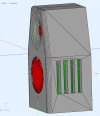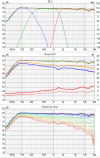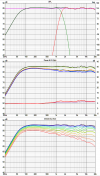Possibly next design iteration on the baffle ports:

Testing in progress:

That's a really innovative way of dealing with the expanse of baffle to either side of your coaxial unit. I would guess that in addition to minimizing the baffle's effective size you are also minimizing the edge effects by partial attenuation, and by spreading those effects out across a much wider time interval, instead of them being concentrated in the time domain as is normally the case with a conventional baffle. My guess is that any residual baffle edge effects are therefore greatly weakened, which would improve not only the frequency response but ALSO (and perhaps more significantly) the image precision, something which does not show up in measurements.
And kudos on your effective cardioid loading, something easier said than done!! You probably had to develop your own "secret sauce(s)" by trial and error as I don't think there are any modelling programs which can handle the multiple complex interactions.
Kudos again on your imo brilliant decision to optimize for use with subwoofers rather than trying to juggle the inevitable tradeoffs involved in squeezing "adequate" bass out of the design. Same thing for your smaller speaker model - imo your global design decisions are very well thought-out.
I tip my virtual hat to you and your full-spectrum "outside the box" thinking.
Last edited:




